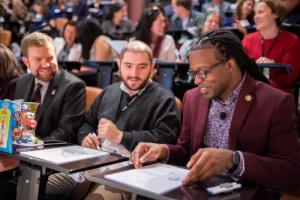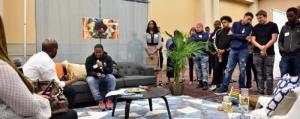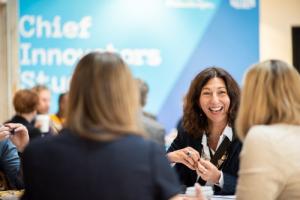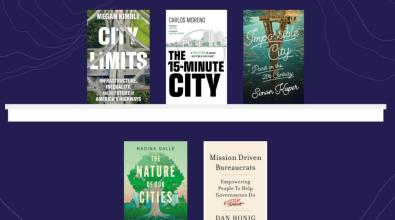Great ideas from 10 city innovators you can borrow right now
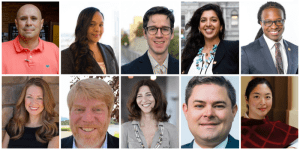
Sharing ideas — openly, freely, and without suspicion. It’s the lifeblood of government innovation. And it’s a core quality that distinguishes the public sector from private. In business, a great idea copied by someone else could provoke a lawsuit. But in local government, it’s cause for celebration. It proves the amplification of your impact.
Helping cities borrow ideas from each other is a big part of our mission at Bloomberg Cities. So, as we publish the 100th edition of our weekly newsletter, Spark, we asked 10 innovative city leaders how they do it. What ideas have you borrowed from other cities? What idea should other cities borrow from you?
Here’s what they had to say.
Have an idea that another city leader should borrow from you? Tweet us about it @BloombergCities
What’s an idea you’ve borrowed from another city?
Brendan Babb, Director of Innovation Team, Anchorage, Alaska
The Anchorage i-team and city Treasury Department worked with the Behavioral Insights Team to improve our non-parking overdue fines letters. We borrowed from the work of Louisville, Ky., and other U.S. cities to improve letters, with pink paper, clear language, calls to action, and “you really need to open this” printed on the envelope in red. The randomized control trial ignited additional employee-led changes that brought in an additional $1 million in revenue over a year.
Dana Berchman, Chief Digital Officer, Gilbert, Ariz.
The idea for the creation of my position, Chief Digital Officer, came from our City Manager, Patrick Banger, who was closely watching what Michael Bloomberg was doing when he was mayor of New York City. We modeled our Digital Roadmap and much of our Digital Government department off of his vision and the work he was doing. Even though the idea was from a large city, you’ll find that there are many principles that apply to a city of any size.
Anjali Chainani, Director of GovLabPHL, Philadelphia
We started a book club for city employees after seeing what Baltimore officials created in their city. We don’t have a website, but we’ve been reading books, sharing podcasts, and having author talks for nearly two years now.
Tracy Colunga, Director of the Office of Civic Innovation, Long Beach, Calif.
The city of Philadelphia has an amazing partnership with their local colleges and universities to solve big city problems. While we have several use-case examples in Long Beach of partnering with local universities, we are looking to formalize the process based on the Philadelphia model.
Tim Moreland, Director of Performance Management and Open Data, Chattanooga, Tenn.
We have borrowed the idea of Peak Academy from Denver, and have begun training frontline staff in process improvement methods, change management and human-centered design to improve service delivery. We are in the process of developing our own data academy to train employees in data skills, after looking at several other cities’ programs, most notably San Francisco’s.
Grace Simrall, Chief of Civic Innovation and Technology, Louisville, Ky.
The Wellbeing Index is an idea that we’ve borrowed from Santa Monica’s winning Mayors Challenge proposal. Julie Rusk and her team created a compelling way to not only measure success in the form of community wellbeing, but also transformed Santa Monica’s culture and budget. In 2018, Louisville Metro Government, in partnership with IDEAS xLAB, embarked on a Year of Arts, HeALIng, and Action! engagements as a customer-discovery platform to design our own Cultural Wellbeing Index. The work continues in partnership with the new University of Louisville Center for Creative Placehealing to further explore how culture shapes health.
Terrance Smith, Director of Innovation Team, Mobile, Ala.
We take lots of pieces from many different cities and make adaptations to fit our current and future needs. We took cues from Syracuse, N.Y., and hired a data person who has a deep understanding and appreciation for the analysis of quantitative data. That gave us the ability to take steps forward on the path to becoming a data-driven city, which we believe will help us build trust with citizens, frontline employees, and other stakeholders. We also borrowed the idea from Miami and Denver to start an innovation academy, which strengthens our ability to help employees on smaller projects that can have an immediate impact, while also boosting our ability to tackle long-term projects.
Juan Carlos Tenorio, Manager for Peace and Civic Culture, Santiago de Cali, Colombia
One idea we are interested in borrowing is from Tulsa, Okla., which is mobilizing volunteers to look at city data to identify and solve common problems in the city. That would help us see connections between multiple city problems, and motivate us to search for solutions together.
James Wagner, Chief Financial Officer, Tulsa, Okla.
The City of Tulsa implemented the Better Way Program in 2018. This program, borrowed from Albuquerque, N.M., has now served over 800 people and has resulted in full-time employment for 66 individuals. The Better Way Program provides individuals experiencing homelessness an alternative to panhandling by offering participants a day’s wages to help beautify the community.
Amalia Zepou, Vice Mayor for Civil Society and Innovation, Athens, Greece
We recently renovated the abandoned Kypseli municipal market in Athens, and turned it into a hub for innovative social entrepreneurs. For inspiration, we looked to a number of other European projects, including ones in Amsterdam, Berlin, and Leipzig. These are places where serendipitous things happen, places where we tell stories about the way citizens and the city work together to change the future of their own neighborhoods.
What’s an idea another city should borrow from you?
Brendan Babb, Director of Innovation Team, Anchorage, Alaska
The Anchorage i-team is completing work on helping more residents file for the Earned Income Tax Credit, inspired by a chat with Mike Bloomberg on a visit to Anchorage. The average credit is more than $2,000, and can be filed for up to three years prior. We are focused on finding residents who haven’t filed taxes in four years and then getting them more than $8,000, which can be life-changing for low- to medium-income households. Cities should take advantage of these federal dollars that flow into local neighborhoods and leverage the well-known April 15 tax filing deadline to spur action.
Dana Berchman, Chief Digital Officer, Gilbert, Ariz.
When we built our Open Data Portal, we took a different approach. We’ve created an interactive, outward facing persona, “Alex,” as our data librarian who helps guide people through the process of using our data and portal. When you visit, Alex gives you information and shows trends and statistics about community safety, growth and development, recreation and culture, finance and operations, and transportation and facilities using real city data. Alex is improving civic engagement and helping residents connect the dots to make government more accessible, improving interactions with residents and businesses.
Anjali Chainani, Director of GovLabPHL, Philadelphia
Our idea to use a trauma-informed, child-focused approach when children are arrested was a winner in the Bloomberg Philanthropies Mayors Challenge. What we’re changing is a system where children who are arrested, even for minor infractions, are detained in cells designed for adults. We’re developing a space designed for the special needs of children, staffed with social workers who have the children’s safety, mental health, and social service needs in mind.
Tracy Colunga, Director of the Office of Civic Innovation, Long Beach, Calif.
The Long Beach Innovation Team has delivered innovative solutions in economic development and public safety. To expand on the great work, the city launched the Office of Civic Innovation in the City Manager’s Office. With funding from departments and foundations, the Office of Civic Innovation serves as in-house consultants to city departments and together co-create effective approaches that address the most pressing issues. This long-term funding strategy can be implemented in other cities. We would be happy to help other cities explore this model.
Grace Simrall, Chief of Civic Innovation and Technology, Louisville, Ky.
Many cities face air-quality challenges that impact the health of their residents. While those with respiratory issues display acute and chronic symptoms, we all breathe the same air. Louisville Metro Government’s Air Louisville initiative crowdsourced data on when and where residents used their asthma inhalers, helping us to identify hotspots and resulting in new policies to address root causes. This opt-in program helped participants learn about their asthma triggers when they shared their data with their respiratory therapist. It resulted in a more than 80-percent reduction in usage of “rescue inhalers” when symptoms flare, and 200-percent increase in asthma-free days.
Terrance Smith, Director of Innovation Team, Mobile, Ala.
We use the Post-It Plus app, to make data collection more efficient when we’re using sticky notes to collect ideas. It saves us a ton of time and also allows us to organize and display our insights quicker, while keeping the actual handwritten notes of each participant. We also have an app for surveying blighted property. It started out as a prototype using Instagram, and our GIS department developed it into a full-fledged app. “Frugal engineering” is what I like to call it.
Juan Carlos Tenorio, Manager for Peace and Civic Culture, Santiago de Cali, Colombia
To combat violence and build trust among neighbors, we have developed local councils who organize trash cleanups, movie nights, and other community-building activities. We give them materials, but they do the work. These councils, or mesas, are creating a path for peaceful resolution of conflicts, growing the public’s understanding and appreciation for diversity as an asset to society, and strengthening citizens’ skill at managing local problems without direct intervention from the city.
James Wagner, Chief Financial Officer, Tulsa, Okla.
The Civic Innovation Fellowship convenes six innovative thinkers from Tulsa to deeply understand and propose solutions to longstanding or emerging civic challenges. The team works on a project for six months using a human-centered design approach, meeting every week for three hours. Fellows also learn the basics of city government so they can become more engaged residents. In addition, we have a program called Tulsa Term, where 12 high school students are spending an entire semester inside City Hall directly engaging with the city through meaningful assignments and projects.
Amalia Zepou, Vice Mayor for Civil Society and Innovation, Athens, Greece
The synAthina platform, where citizens leading grassroots initiatives connect with each other, is a replicable model we would encourage other cities to explore and see how it fits best in the work they do with their local communities. Developing creative citizenship, community building, and creating better public spaces by investing in the local creative community’s assets, inspiration, and potential is the main aspect of the work we are proud to share with other cities.
